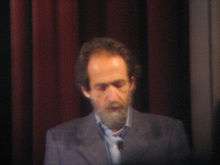Jorge E. Hirsch
| Jorge E. Hirsch | |
|---|---|
 Professor Jorge E. Hirsch giving a talk | |
| Born |
1953 (age 62–63) Buenos Aires, Argentina |
| Nationality | Argentine American |
| Fields | Physicist |
| Thesis | Low-temperature thermodynamic properties of a random anisotropic antiferromagnetic chain (1980) |
Jorge Eduardo Hirsch (born 1953) is an Argentine American professor of physics at the University of California, San Diego.[1] He is known for inventing the h-index in 2005, an index for quantifying a scientist's publication productivity and the basis of several scholar indices.[2][3]
Background
Hirsch was born in Buenos Aires, Argentina. He earned an undergraduate degree at the University of Buenos Aires, and a CONICET research fellowship in 1975. A Fulbright Scholarship awarded to him in 1976 took him to the University of Chicago, where he received a Telegdi Prize for the best Candidacy Examination in 1977 and was awarded the Victor J. Andrew Memorial Fellowship in 1978. He received his PhD from the University of Chicago in 1980 and served as a post-doctoral research associate in the Kavli Institute for Theoretical Physics at the University of California, Santa Barbara. Following this experience, he joined the University of California, San Diego Department of Physics in 1983.[4]
Research
Physics
Hirsch's scientific work is involved with understanding collective, large-scale properties of solids, such as superconductivity and ferromagnetism, based on explanations starting from small-scale mechanisms. Hirsch's most significant work would be his attempt to unify theories of superconductivity with his theory of hole superconductivity which suggests pairing of electron holes that would lead to high temperature superconductivity as opposed to pairing of electrons in conventional BCS theory.[5] He believes that there is a single mechanism of superconductivity for all materials that explains the Meissner effect and differs from the conventional mechanism in several fundamental aspects.
Bibliometrics
The h-index proposed by Hirsch in 2005[2] became a widely known alternative bibliometric parameter that combines both numbers of articles published by a given scientist and the numbers of citations of those articles in a single parameter.[6]
Nuclear war analyses
Some examples of Hirsch's claims during early 2006 were that "multiple pieces of independent evidence suggest that America is embarked in a premeditated path that will lead inexorably to the use of nuclear weapons against Iran in the very near future"[7] and that "neither the media nor Congress are bringing up the inconvenient little fact that the military option will necessarily lead to the use of nuclear weapons against Iran."[8]
He also speculated that in order to justify an attack on Iran using nuclear weapons, US authorities might make a false, but difficult to disprove, claim that Iranian biologists are trying to develop a strain of the H5N1 avian flu virus which would be transmissible from human to human, and which would be transported to Europe by birds migrating north with the onset of the northern summer of 2006.[9] Later, a human to human transmissible strain was found to have emerged in Southeast Asia and is documented by the WHO.[10]
In April 2006, Hirsch initiated a letter to President George W. Bush, co-signed by twelve other physicists, warning of the dangers of using tactical nuclear weapons against Iran.[11] The letter, dated April 17, was in response to articles in The New Yorker and The Washington Post that indicated the Pentagon was actively considering such options.
References
- ↑ "Jorge Hirsch". Physics.ucsd.edu. Retrieved 2010-08-29.
- 1 2 Hirsch, J. E. (15 November 2005). "An index to quantify an individual's scientific research output". PNAS. 102 (46): 16569–16572. arXiv:physics/0508025
 . Bibcode:2005PNAS..10216569H. doi:10.1073/pnas.0507655102. PMC 1283832
. Bibcode:2005PNAS..10216569H. doi:10.1073/pnas.0507655102. PMC 1283832 . PMID 16275915. Retrieved 13 May 2010. (see also pdf format)
. PMID 16275915. Retrieved 13 May 2010. (see also pdf format) - ↑ Your h-score
- ↑ "Mark Machina and Jorge Hirsch receive Sloan Research Fellowships". libraries.ucsd.edu. Retrieved 2011-01-25.
- ↑ http://physics.ucsd.edu/~jorge/abstracts/bcs.pdf - BCS theory of superconductivity: it is time to question its validity
- ↑ "Jorge Hirsch: the man behind the metric". Research Trends. December 2009.
- ↑ How to Stop the Planned Nuking of Iran: Congress should enact emergency legislation, January 9, 2006, Jorge Hirsch
- ↑ America and Iran: At the Brink of the Abyss - We can stop a "preemptive" nuclear strike, February 20, 2006, Jorge Hirsch
- ↑ Iran and Bird Flu: The Perfect Casus Belli?, March 15, 2006, Jorge Hirsch
- ↑ Human Transmission in One Third of Bird Flu Cases
- ↑ Prominent U.S. Physicists Send Letter to President Bush, Call Nuclear Weapons Against Iran ‘Gravely Irresponsible’, Kim McDonald, April 17, 2006, UCSD News